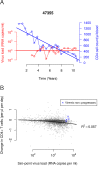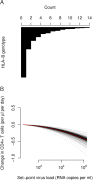Disentangling human tolerance and resistance against HIV
- PMID: 25226169
- PMCID: PMC4165755
- DOI: 10.1371/journal.pbio.1001951
Disentangling human tolerance and resistance against HIV
Abstract
In ecology, "disease tolerance" is defined as an evolutionary strategy of hosts against pathogens, characterized by reduced or absent pathogenesis despite high pathogen load. To our knowledge, tolerance has to date not been quantified and disentangled from host resistance to disease in any clinically relevant human infection. Using data from the Swiss HIV Cohort Study, we investigated if there is variation in tolerance to HIV in humans and if this variation is associated with polymorphisms in the human genome. In particular, we tested for associations between tolerance and alleles of the Human Leukocyte Antigen (HLA) genes, the CC chemokine receptor 5 (CCR5), the age at which individuals were infected, and their sex. We found that HLA-B alleles associated with better HIV control do not confer tolerance. The slower disease progression associated with these alleles can be fully attributed to the extent of viral load reduction in carriers. However, we observed that tolerance significantly varies across HLA-B genotypes with a relative standard deviation of 34%. Furthermore, we found that HLA-B homozygotes are less tolerant than heterozygotes. Lastly, tolerance was observed to decrease with age, resulting in a 1.7-fold difference in disease progression between 20 and 60-y-old individuals with the same viral load. Thus, disease tolerance is a feature of infection with HIV, and the identification of the mechanisms involved may pave the way to a better understanding of pathogenesis.
Conflict of interest statement
The authors have declared that no competing interests exist.
Figures




 (red curve), and a deviation of the random effects,
(red curve), and a deviation of the random effects,  , of
, of  (see Text S1).
(see Text S1).References
-
- Simms EL (2000) Defining tolerance as a norm of reaction. Evolutionary Ecology 14: 563–570.
-
- Boots M (2008) Fight or learn to live with the consequences? Trends Ecol Evol (Amst) 23: 248–250. - PubMed
Publication types
MeSH terms
Substances
LinkOut - more resources
Full Text Sources
Other Literature Sources
Medical
Research Materials

